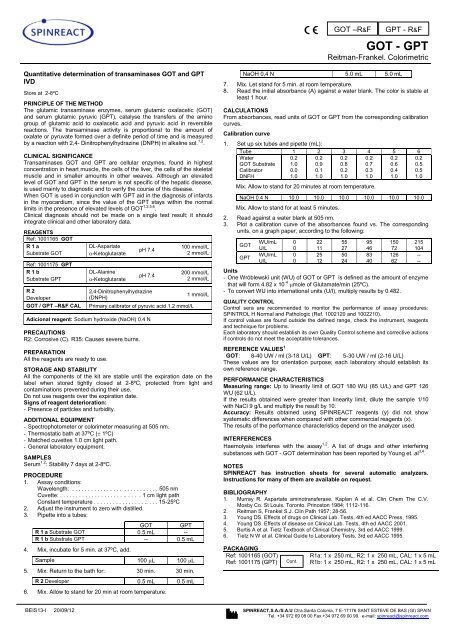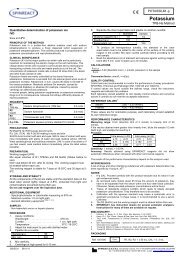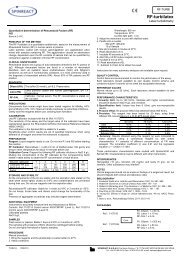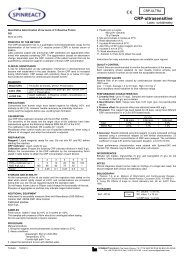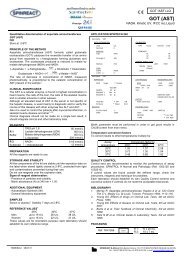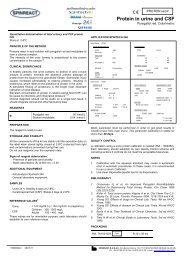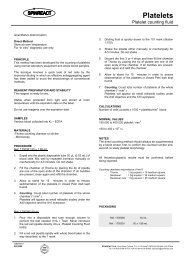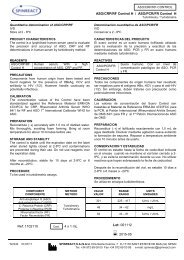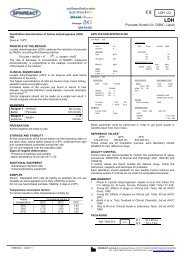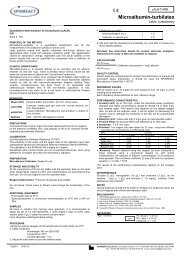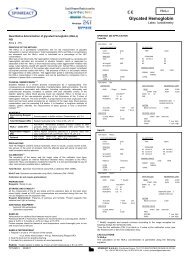GOT - GPT
GOT - GPT - Spinreact
GOT - GPT - Spinreact
You also want an ePaper? Increase the reach of your titles
YUMPU automatically turns print PDFs into web optimized ePapers that Google loves.
<strong>GOT</strong> –R&F<br />
<strong>GPT</strong> - R&F<br />
<strong>GOT</strong> - <strong>GPT</strong><br />
Reitman-Frankel. Colorimetric<br />
Quantitative determination of transaminases <strong>GOT</strong> and <strong>GPT</strong><br />
IVD<br />
Store at 2-8ºC<br />
PRINCIPLE OF THE METHOD<br />
The glutamic transaminase enzymes, serum glutamic oxalacetic (<strong>GOT</strong>)<br />
and serum glutamic pyruvic (<strong>GPT</strong>), catalyse the transfers of the amino<br />
group of glutamic acid to oxalacetic acid and pyruvic acid in reversible<br />
reactions. The transaminase activity is proportional to the amount of<br />
oxalate or pyruvate formed over a definite period of time and is measured<br />
by a reaction with 2,4- Dinitrophenylhydrazine (DNPH) in alkaline sol. 1,2 .<br />
CLINICAL SIGNIFICANCE<br />
Transaminases <strong>GOT</strong> and <strong>GPT</strong> are cellular enzymes, found in highest<br />
concentration in heart muscle, the cells of the liver, the cells of the skeletal<br />
muscle and in smaller amounts in other weaves. Although an elevated<br />
level of <strong>GOT</strong> and <strong>GPT</strong> in the serum is not specific of the hepatic disease,<br />
is used mainly to diagnostic and to verify the course of this disease.<br />
When <strong>GOT</strong> is used in conjunction with <strong>GPT</strong> aid in the diagnosis of infarcts<br />
in the myocardium, since the value of the <strong>GPT</strong> stays within the normal<br />
limits in the presence of elevated levels of <strong>GOT</strong> 1,2,5,6 .<br />
Clinical diagnosis should not be made on a single test result; it should<br />
integrate clinical and other laboratory data.<br />
REAGENTS<br />
Ref: 1001165 <strong>GOT</strong><br />
R 1 a<br />
Substrate <strong>GOT</strong><br />
Ref: 1001175 <strong>GPT</strong><br />
R 1 b<br />
Substrate <strong>GPT</strong><br />
R 2<br />
Developer<br />
<strong>GOT</strong> / <strong>GPT</strong> –R&F CAL<br />
DL-Aspartate<br />
-Ketoglutarate<br />
DL-Alanine<br />
-Ketoglutarate<br />
pH 7.4<br />
pH 7.4<br />
2,4-Dinitrophenylhydrazine<br />
(DNPH)<br />
Primary calibrator of pyruvic acid 1.2 mmol/L<br />
Adicional reagent: Sodium hydroxide (NaOH) 0.4 N<br />
PRECAUTIONS<br />
R2: Corrosive (C). R35: Causes severe burns.<br />
PREPARATION<br />
All the reagents are ready to use.<br />
100 mmol/L<br />
2 mmol/L<br />
200 mmol/L<br />
2 mmol/L<br />
1 mmol/L<br />
STORAGE AND STABILITY<br />
All the components of the kit are stable until the expiration date on the<br />
label when stored tightly closed at 2-8ºC, protected from light and<br />
contaminations prevented during their use.<br />
Do not use reagents over the expiration date.<br />
Signs of reagent deterioration:<br />
- Presence of particles and turbidity.<br />
ADDITIONAL EQUIPMENT<br />
- Spectrophotometer or colorimeter measuring at 505 nm.<br />
- Thermostatic bath at 37ºC ( 1ºC)<br />
- Matched cuvettes 1.0 cm light path.<br />
- General laboratory equipment.<br />
SAMPLES<br />
Serum 1,2 : Stability 7 days at 2-8ºC.<br />
PROCEDURE<br />
1. Assay conditions:<br />
Wavelength: . . . . . . . . . . . . . . . . . . . . . . . . . . . 505 nm<br />
Cuvette: . . . . . . . . . . . . . . . . . . . . .. . . . . 1 cm light path<br />
Constant temperature . . . . . . . . . . . . . . . . .. . . . 15-25ºC<br />
2. Adjust the instrument to zero with distilled.<br />
3. Pipette into a tubes:<br />
<strong>GOT</strong> <strong>GPT</strong><br />
R 1 a Substrate <strong>GOT</strong> 0.5 mL --<br />
R 1 b Substrate <strong>GPT</strong> -- 0.5 mL<br />
4. Mix, incubate for 5 min. at 37ºC, add.<br />
Sample 100 L 100 L<br />
5. Mix. Return to the bath for: 30 min. 30 min.<br />
R 2 Developer 0.5 mL 0.5 mL<br />
6. Mix. Allow to stand for 20 min at room temperature.<br />
NaOH 0,4 N 5.0 mL 5.0 mL<br />
7. Mix. Let stand for 5 min. at room temperature.<br />
8. Read the initial absorbance (A) against a water blank. The color is stable at<br />
least 1 hour.<br />
CALCULATIONS<br />
From absorbances, read units of <strong>GOT</strong> or <strong>GPT</strong> from the corresponding calibration<br />
curves.<br />
Calibration curve<br />
1. Set up six tubes and pipette (mL):<br />
Tube 1 2 3 4 5 6<br />
Water<br />
0.2 0.2 0.2 0.2 0.2 0.2<br />
<strong>GOT</strong> Substrate 1.0 0.9 0.8 0.7 0.6 0.5<br />
Calibrator<br />
0.0 0.1 0.2 0.3 0.4 0.5<br />
DNFH<br />
1.0 1.0 1.0 1.0 1.0 1.0<br />
Mix. Allow to stand for 20 minutes at room temperature.<br />
NaOH 0.4 N 10.0 10.0 10.0 10.0 10.0 10.0<br />
Mix. Allow to stand for at least 5 minutes.<br />
2. Read against a water blank at 505 nm.<br />
3. Plot a calibration curve of the absorbances found vs. The corresponding<br />
units, on a graph paper, according to the following:<br />
<strong>GOT</strong><br />
<strong>GPT</strong><br />
WU/mL<br />
U/L<br />
WU/mL<br />
U/L<br />
Units<br />
- One Wróblewski unit (WU) of <strong>GOT</strong> or <strong>GPT</strong> is defined as the amount of enzyme<br />
that will form 4.82 x 10 -4 mole of Glutamate/min (25ºC).<br />
- To convert WU into international units (U/I), multiply results by 0.482.<br />
QUALITY CONTROL<br />
Control sera are recommended to monitor the performance of assay procedures:<br />
SPINTROL H Normal and Pathologic (Ref. 1002120 and 1002210).<br />
If control values are found outside the defined range, check the instrument, reagents<br />
and technique for problems.<br />
Each laboratory should establish its own Quality Control scheme and corrective actions<br />
if controls do not meet the acceptable tolerances.<br />
REFERENCE VALUES 1<br />
<strong>GOT</strong>: 8-40 UW / ml (3-18 U/L) <strong>GPT</strong>: 5-30 UW / ml (2-16 U/L)<br />
These values are for orientation purpose; each laboratory should establish its<br />
own reference range.<br />
PERFORMANCE CHARACTERISTICS<br />
Measuring range: Up to linearity limit of <strong>GOT</strong> 180 WU (85 U/L) and <strong>GPT</strong> 126<br />
WU (62 U/L).<br />
If the results obtained were greater than linearity limit, dilute the sample 1/10<br />
with NaCl 9 g/L and multiply the result by 10.<br />
Accuracy: Results obtained using SPINREACT reagents (y) did not show<br />
systematic differences when compared with other commercial reagents (x).<br />
The results of the performance characteristics depend on the analyzer used.<br />
INTERFERENCES<br />
Haemolysis interferes with the assay 1,2 . A list of drugs and other interfering<br />
substances with <strong>GOT</strong> - <strong>GOT</strong> determination has been reported by Young et. al 3,4 .<br />
NOTES<br />
SPINREACT has instruction sheets for several automatic analyzers.<br />
Instructions for many of them are available on request.<br />
BIBLIOGRAPHY<br />
1. Murray R. Aspartate aminotransferase. Kaplan A et al. Clin Chem The C.V.<br />
Mosby Co. St Louis. Toronto. Princeton 1984; 1112-116.<br />
2. Reitman S, Frankel S.J. Clin Path 1957; 28-56.<br />
3. Young DS. Effects of drugs on Clinical Lab. Tests, 4th ed AACC Press, 1995.<br />
4. Young DS. Effects of disease on Clinical Lab. Tests, 4th ed AACC 2001.<br />
5. Burtis A et al. Tietz Textbook of Clinical Chemistry, 3rd ed AACC 1999.<br />
6. Tietz N W et al. Clinical Guide to Laboratory Tests, 3rd ed AACC 1995.<br />
PACKAGING<br />
Ref: 1001165 (<strong>GOT</strong>)<br />
Ref: 1001175 (<strong>GPT</strong>)<br />
0<br />
0<br />
0<br />
0<br />
Cont.<br />
22<br />
11<br />
25<br />
12<br />
55<br />
27<br />
50<br />
24<br />
95<br />
46<br />
83<br />
40<br />
150<br />
72<br />
126<br />
62<br />
215<br />
104<br />
--<br />
--<br />
R1a: 1 x 250 mL, R2: 1 x 250 mL, CAL: 1 x 5 mL<br />
R1b: 1 x 250 mL, R2: 1 x 250 mL, CAL: 1 x 5 mL<br />
BEIS13-I 20/09/12 SPINREACT,S.A./S.A.U Ctra.Santa Coloma, 7 E-17176 SANT ESTEVE DE BAS (GI) SPAIN<br />
Tel. +34 972 69 08 00 Fax +34 972 69 00 99. e-mail: spinreact@spinreact.com
<strong>GOT</strong> –R&F<br />
<strong>GPT</strong> - R&F<br />
<strong>GOT</strong> - <strong>GPT</strong><br />
Reitman-Frankel. Colorimétrico<br />
Determinación cuantitativa de transaminasas <strong>GOT</strong> y <strong>GPT</strong><br />
IVD<br />
Conservar a 2-8ºC<br />
PRINCIPIO DEL MÉTODO<br />
Las transaminasas catalizan la transferencia del grupo amino del<br />
aspartato (<strong>GOT</strong>) o de la alanina (<strong>GPT</strong>) al -cetoglutarato. El cetoácido<br />
formado, oxalacético o pirúvico respectivamente, en presencia de 2,4-<br />
Dinitrofenilhidrazina (DNFH) da la hidrazona correspondiente con una<br />
coloración medible en medio alcalino 1,2 .<br />
SIGNIFICADO CLÍNICO<br />
Las transaminasas <strong>GOT</strong> y <strong>GPT</strong> son enzimas intracelulares que se<br />
encuentra en niveles altos en el músculo del corazón, las células del<br />
hígado, las células del músculo esquelético y en menores cantidades en<br />
otros tejidos.<br />
Aunque un nivel elevado de <strong>GOT</strong> y la <strong>GPT</strong> en el suero no es específico de<br />
enfermedad hepática se emplea principalmente para su diagnóstico y<br />
seguimiento. El empleo de la <strong>GOT</strong> en conjunción con la <strong>GPT</strong> ayuda en el<br />
diagnóstico de infartos de miocardio, ya que el valor de la <strong>GPT</strong> se<br />
mantiene dentro de los límites normales y aumenta los niveles de<br />
<strong>GOT</strong> 1,2,5,6 .<br />
El diagnóstico clínico debe realizarse teniendo en cuenta todos los datos<br />
clínicos y de laboratorio.<br />
REACTIVOS<br />
Ref: 1001165 <strong>GOT</strong><br />
R1a<br />
Substrato <strong>GOT</strong><br />
Ref: 1001175 <strong>GPT</strong><br />
R1b<br />
Substrato <strong>GPT</strong><br />
R2<br />
Revelador<br />
<strong>GOT</strong> / <strong>GPT</strong> –R&F CAL<br />
DL-Aspartato<br />
-Cetoglutarato<br />
DL-Alanina<br />
-Cetoglutarato<br />
pH 7,4<br />
pH 7,4<br />
2,4-Dinitrofenilhidrazina<br />
(DNFH)<br />
Reactivo adicional: Hidróxido sódico (NaOH) 0,4 N<br />
100 mmol/L<br />
2 mmol/L<br />
200 mmol/L<br />
2 mmol/L<br />
1 mmol/L<br />
Calibrador primario de ácido pirúvico 1,2 mmol/L<br />
PRECAUCIONES<br />
R2: Corrosivo (C): R35: Provoca quemaduras graves.<br />
PREPARACIÓN<br />
Todos los reactivos están listo para su uso.<br />
CONSERVACIÓN Y ESTABILIDAD<br />
Todos los componentes del kit son estables, hasta la fecha de caducidad<br />
indicada en la etiqueta del vial, cuando se mantienen los viales bien<br />
cerrados a 2-8ºC, protegidos de la luz y se evita su contaminación.<br />
No usar reactivos fuera de la fecha indicada.<br />
Indicadores de deterioro de los reactivos:<br />
- Presencia de partículas y turbidez.<br />
MATERIAL ADICIONAL<br />
- Espectrofotómetro o analizador para lecturas a 505 nm.<br />
- Baño termostatable a 37ºC ( 1ºC)<br />
- Cubetas de 1,0 cm de paso de luz.<br />
- Equipamiento habitual de laboratorio.<br />
MUESTRAS<br />
Suero 1,2 . Estabilidad de la muestra: 7 días a 2-8ºC.<br />
PROCEDIMIENTO<br />
1. Condiciones del ensayo:<br />
Longitud de onda: . . . . . . . . . . . . . . . . . . . . . . .505 nm<br />
Cubeta:. . . . . . . . . . . . . . . . . . . . . . . . .1 cm paso de luz<br />
Temperatura . . . . . . . . . . . . . . . .. . . . . . . . . . . .15-25ºC<br />
2. Ajustar el espectrofotómetro a cero frente a agua destilada.<br />
3. Pipetear en un tubos de ensayo:<br />
<strong>GOT</strong> <strong>GPT</strong><br />
R1a Substrato <strong>GOT</strong> 0,5 mL --<br />
R1b Substrato <strong>GPT</strong> -- 0,5 mL<br />
4. Incubar 5 min. a 37ºC, añadir<br />
Muestra 100 L 100 L<br />
5. Mezclar e incubar a 37ºC, durante: 30 min. 30 min.<br />
R2 Revelador 0,5 mL 0,5 mL<br />
6. Mezclar y dejar 20 min. a temperatura ambiente y añadir:<br />
NaOH 0,4 N 5,0 mL 5,0 mL<br />
7. Mezclar y dejar reposar 5 min. a temperatura ambiente<br />
8. Leer la absorbancia (A) frente a agua destilada. El color es estable como<br />
mínimo 1 hora.<br />
CÁLCULOS<br />
Los valores de la actividad <strong>GOT</strong> y <strong>GPT</strong> se hallan interpolando la absorbancia<br />
hallada para el problema con la curva de calibración.<br />
Curva de calibración<br />
1. En tubos de ensayo Pipetear (mL):<br />
Tubo 1 2 3 4 5 6<br />
Agua<br />
0,2 0,2 0,2 0,2 0,2 0,2<br />
Substrato <strong>GOT</strong> 1,0 0,9 0,8 0,7 0,6 0,5<br />
Calibrador 0,0 0,1 0,2 0,3 0,4 0,5<br />
DNFH<br />
1,0 1,0 1,0 1,0 1,0 1,0<br />
Mezclar bien y dejar 20 min. a temperatura ambiente.<br />
NaOH 0,4 N 10,0 10,0 10,0 10,0 10,0 10,0<br />
Mezclar bien y dejar 5 min. a temperatura ambiente.<br />
2. Leer la absorbancia (A) de todos los tubos, frente a agua destilada.<br />
3. Representar gráficamente los resultados, colocando las absorbancias en<br />
ordenadas y las unidades en abcisas, de acuerdo con la siguiente relación:<br />
<strong>GOT</strong><br />
<strong>GPT</strong><br />
WU/mL<br />
U/L<br />
WU/mL<br />
U/L<br />
Unidades<br />
- Una unidad Wróblewski (UW) de <strong>GOT</strong> o <strong>GPT</strong> se define como la cantidad de<br />
enzima que forma 4,82 x 10 -4 mol de Glutamato/min (25ºC).<br />
- Para convertir las UW a U/I multiplicar por 0,482.<br />
CONTROL DE CALIDAD<br />
Es conveniente analizar junto con las muestras sueros control valorados:<br />
SPINTROL H Normal y Patológico (Ref. 1002120 y 1002210).<br />
Si los valores hallados se encuentran fuera del rango de tolerancia, se debe<br />
revisar el instrumento, los reactivos y la técnica.<br />
Cada laboratorio debe disponer su propio Control de Calidad y establecer<br />
correcciones en el caso de que los controles no cumplan con las tolerancias.<br />
VALORES DE REFERENCIA 1<br />
<strong>GOT</strong>: 8-40 UW / ml (3-18 U/L) <strong>GPT</strong>: 5-30 UW / ml (2-16 U/L)<br />
Estos valores son orientativos. Es recomendable que cada laboratorio<br />
establezca sus propios valores de referencia.<br />
CARACTERÍSTICAS DEL MÉTODO<br />
Rango de medida: Desde el límite de detección hasta el límite de linealidad<br />
180 UW/ml para la <strong>GOT</strong> y 126 UW/ml para la <strong>GPT</strong><br />
Si la concentración de la muestra es superior al límite de linealidad, diluir 1/10<br />
con ClNa 9 g/L y multiplicar el resultado final por 10.<br />
Exactitud: Los reactivos SPINREACT (y) no muestran diferencias sistemáticas<br />
significativas cuando se comparan con otros reactivos comerciales (x).<br />
Las características del método pueden variar según el analizador utilizado.<br />
INTERFERENCIAS<br />
La hemólisis interfiere con la determinación 1,2 . Se han descrito varias drogas y<br />
otras substancias que interfieren en la determinación de <strong>GOT</strong> y <strong>GPT</strong> 3,4 .<br />
NOTAS<br />
SPINREACT dispone de instrucciones detalladas para la aplicación de este<br />
reactivo en distintos analizadores.<br />
BIBLIOGRAFÍA<br />
1. Murray R. Aspartate aminotransferase. Kaplan A et al. Clin Chem The C.V.<br />
Mosby Co. St Louis. Toronto. Princeton 1984; 1112-116.<br />
2. Reitman S, Frankel S.J. Clin Path 1957; 28-56.<br />
3. Young DS. Effects of drugs on Clinical Lab. Tests, 4th ed AACC Press, 1995.<br />
4. Young DS. Effects of disease on Clinical Lab. Tests, 4th ed AACC 2001.<br />
5. Burtis A et al. Tietz Textbook of Clinical Chemistry, 3rd ed AACC 1999.<br />
6. Tietz N W et al. Clinical Guide to Laboratory Tests, 3rd ed AACC 1995.<br />
PRESENTACIÓN<br />
Ref: 1001165 (<strong>GOT</strong>)<br />
Ref: 1001175 (<strong>GPT</strong>)<br />
0<br />
0<br />
0<br />
0<br />
Cont.<br />
22<br />
11<br />
25<br />
12<br />
55<br />
27<br />
50<br />
24<br />
95<br />
46<br />
83<br />
40<br />
150<br />
72<br />
126<br />
62<br />
215<br />
104<br />
--<br />
--<br />
R1a: 1 x 250 mL, R2: 1 x 250 mL, CAL: 1 x 5 mL<br />
R1b: 1 x 250 mL, R2: 1 x 250 mL, CAL: 1 x 5 mL<br />
BEIS13-E 20/09/12 SPINREACT,S.A./S.A.U Ctra.Santa Coloma, 7 E-17176 SANT ESTEVE DE BAS (GI) SPAIN<br />
Tel. +34 972 69 08 00 Fax +34 972 69 00 99. e-mail: spinreact@spinreact.com


